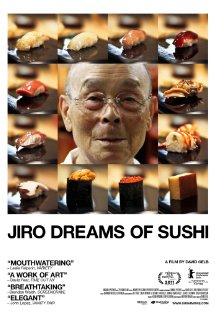
 When I saw the listing for Jiro Dreams of Sushi I figured that I had better move fast if I wanted to see it in a theater. I suspect this documentary has a somewhat specialized appeal. If you are a big fan of sushi, or if like me you are somewhat obsessed with Japanese culture, then you probably want to see it. Or maybe if you are just fascinated with someone’s quest for absolute perfection. I don’t think this is for mainstream audiences though.
When I saw the listing for Jiro Dreams of Sushi I figured that I had better move fast if I wanted to see it in a theater. I suspect this documentary has a somewhat specialized appeal. If you are a big fan of sushi, or if like me you are somewhat obsessed with Japanese culture, then you probably want to see it. Or maybe if you are just fascinated with someone’s quest for absolute perfection. I don’t think this is for mainstream audiences though.
Jirou Ono is the 85-year-old owner of a little 10-seat sushi bar hidden away in Tokyo’s Ginza subway station. (Yes, I’m writing his name in romaji. I tend to get cranky when I see a Japanese name and am not sure how to pronounce it.) The place doesn’t look all that impressive but it’s the first sushi restaurant ever to get the maximum 3-star rating in the Michelin Guide. Reservations must be made at least a month in advance. The price of a meal starts at 30,000 Yen (about US$ 360).
(This is why most Japanese people rarely eat sushi. The good stuff, prepared by a top chef, tends to be ridiculously expensive. Even the popular kaitenzushi (“sushi-go-round”) restaurants aren’t cheap by Japanese food standards. A couple of those little plates can easily run you 1,000 Yen, far more than the cost of a lunch set at a noodle shop.)
Jirou, as one might expect, is the consummate workaholic, totally devoted to his business, regarded with awe and maybe a little fear by everyone who knows him. He lives, breathes and even dreams about sushi. Sometimes his dreams give him useful new ideas on how to prepare sushi, such as massaging the octopus for 45 minutes instead of 30 to improve its texture.
OK, it’s easy to make fun of this, but it is a rather inspiring story of someone who suffered great hardships and worked his way up from nothing to become the leader of his field. In the last scene we see him praying at the grave of the father who abandoned him when he was seven years old. It seems a quintessentially Japanese ending for a quintessentially Japanese story.

